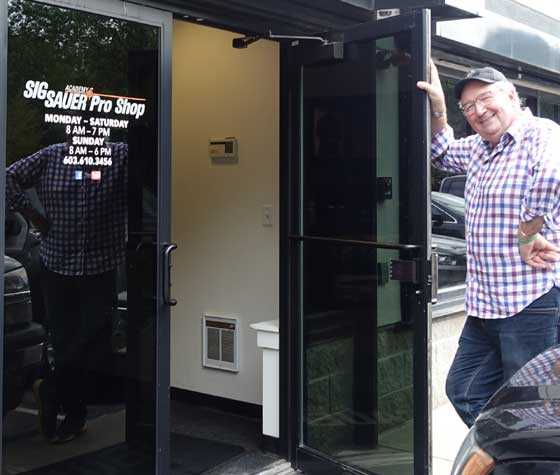

We were never able to achieve the 430 f.p.s. To 380 f.p.s., with the overall average being 375 f.p.s. We performed our tests when the air temperatures were averaging 75 degrees F.

We are situated on a high mesa in New Mexico at an elevation of 4,835 ft above sea level. We used Sig SAUER 5.25 grain match ballistic alloy pellets for our tests. Jim took the gun outside and set up our SIG QUAD shooting gallery at 15 yards and prepared our Caldwell G2 Chronograph to record the average velocity of the pellets. Now it is time to get serious and determine whether this piece will deliver the advertised 430 f.p.s. Make sure that the ambidextrous thumb safety is on before inserting the magazine/CO2 housing unit…. When finished, insert the magazine back into the housing and replace the housing into the grip of the M17, as you would do in loading any semi-automatic pistol. To load pellets, simply depress the recessed button on the front of the housing (not visible in the picture) and the magazine drops out for loading. done! The cam lever loading system is unique and patented by SIG. Simply pull the cam lever down, drop in a cylinder and close the cam lever…. SIG SAUER M17 ASP Air Pistol Magzine Cutaway The quick release magazine button drops out both the 20 round magazine and the housing for the 12 gram CO2 cylinder. Preparing the M17 for shooting is incredibly easy. However, as good as this gun looks and handles, the major question is: “How does it shoot?” In order to be an effective training piece the gun must cycle through the 20 round magazine without jamming and it must be accurate.

When handling the ASP, it is very easy to forget that you have an air pistol in your hands and not a centerfire pistol. Although the M17 centerfire is lighter than the M17 ASP when empty (29.4 oz vs 34.4 oz), they are comparable when the M17 is loaded.Īll things considered, the M17 ASP is as perfect a functioning clone that is possible. The physical measurements of the M17 ASP are virtually identical to its centerfire counterpart. This pistol has the same look and feel as the polymer frame of the M17 centerfire pistol, including a metal slide with a blow-back action. The M17 ASP can be field stripped (the P320 ASP could not), not only simulating its centerfire “parent” but making it easy to remove a jammed pellet, should that occur. The newly designed 20-round magazine (RPM – Rapid Pellet Magazine) of the M17 ASP does not have those problems and consistently feeds smoothly. They are two distinct and separate clones of two distinct and separate firearms.įor starters, the P320 ASP had a 30-round magazine which had occasional issues in feeding. At this point, we should point out that the M17 ASP is NOT the same as the P320 ASP air pistol. It was only logical that SIG produce a replicate clone air pistol of the M17 for training purposes.


 0 kommentar(er)
0 kommentar(er)
